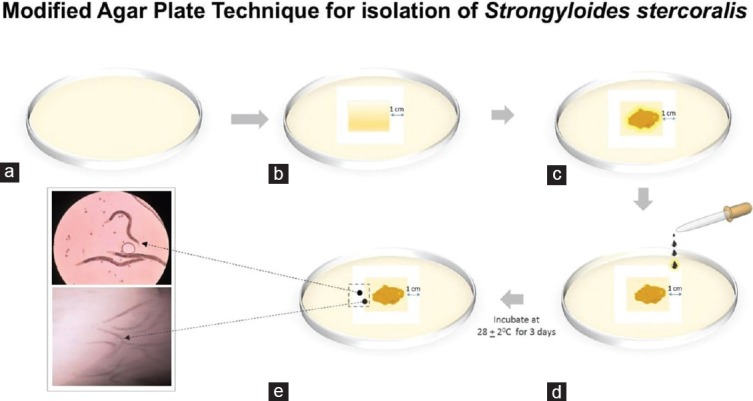Sir,
A number of techniques have been developed to recognize larvae of Strongyloides stercoralis in stool samples, including direct smear of faeces in saline–Lugol iodine stain, Baermann concentration, formalin-ethyl acetate concentration, Harada-Mori filter paper culture and nutrient agar plate cultures.[1,2,3] We propose a novel method to recognize as well as preserve larvae and adult worms.
Approximately 1 cm wide canal is cut across with a surgical blade around a central square piece of agar of 2 cm × 2 cm in a nutrient agar plate. The canal is filled with distilled water or normal saline using a disposable glass or a plastic pipette. Approximately 2 g of fresh stool sample is placed on the central square piece of agar. The plastic lid is replaced and sealed with cellulose tape or shrink seal. The agar plate is maintained upright at room temperature (25 ± 2°C) for at least 2 days. After 2 days, the sealed plate is examined through the plastic lid under the ×10 objective (low power) of the microscope for colonies that develop as random tracks on the central square piece of agar.[4] and motile larvae, as well as adult worms, moving actively in the distilled water or normal saline filled in the canal [Figure 1]. The plates can be observed for 3 consecutive days for isolation of parasites in a large quantity. It has been documented that daily search for furrows on the agar piece and worms in the distilled water or normal saline filled canal for up to 3 consecutive days results in increased sensitivity for diagnosis of S. stercoralis infections.[5] At the end of 3 days, with the end of hot forceps (heat the end of the forceps until able to melt plastic), make a hole in the lid of the petri dish just above the canal. With proper safety precautions, the live larvae and adult worms can be pipetted out and eggs can also be observed under the guidance of an expert parasitologist. It is also feasible to add 1 ml of 10% formalin through the hole into the canal and pipette out the distilled water with formalin filled in the canal containing dead larvae and adult worms. Prepare a wet mount preparation and examine using the ×10 objective (low power) for the presence of larvae. If larvae are found, confirm identification using ×40 objective (high dry power).
Figure 1.

Schematic representations of modified agar techniques for Strongyloides stercorails (a). Nutrients plate (b) 1 x 1 cm well cut in the nutrient agar. (c) Inoculation of stool at the center. (d) Well filled with Distilled water/Normal saline. (e) Microscopic observstion under low power (x10)
Infective larvae may be found any time after the 2nd or 3rd day or even on the 1st day in case of heavy infection. Since infective larvae may be present on the nutrient agar and canal around the square piece, plates should be handled carefully. It is essential to maintain the plates in an upright position at room temperature. Plates should not be incubated or refrigerated at any time; this also applies to the fresh stool specimen. Fresh stool is required for this procedure; preserved faecal specimens or specimens obtained after a barium meal are not suitable for processing this method.
Analytical considerations
To ensure reliable results, follow a routine procedure for optimal collection and handling of specimens for parasitological examination
Examine agar plates to ensure that there is no cracking and the agar pour is sufficient to prevent drying. Furthermore, make sure there is no excess water on the surface of the plates.
Advantages of the procedure
To the best of our knowledge, the type of modification of agar plate culture which we have employed is nowhere mentioned in the literature. It is a novel technique for preservation and identification of larvae, adult worms and eggs of S. stercoralis. It is also useful for isolation of pure forms of larval and adult stages of the organism. The preserved larvae, adult worms and eggs can be used for antigen extraction and serology based research. This technique can be employed for isolation and preservation of hookworm such as Ankylostoma duodenale. When compared to other methods such as Harada-Mori, Bearman's techniques and agar plate culture, our technique had better yield of parasites.
Limitations of the procedure
This technique is successful if any larvae present are viable. If the fresh stool specimen is too old, larvae may not survive, and a false negative result will be reported. Specimens that have been refrigerated or preserved are not suitable for this type of culture method. There is a chance of infection in case of mishandling.
REFERENCES
- 1.Arakaki T, Iwanaga M, Kinjo F, Saito A, Asato R, Ikeshiro T. Efficacy of agar-plate culture in detection of Strongyloides stercoralis infection. J Parasitol. 1990;76:425–8. [PubMed] [Google Scholar]
- 2.Garcia LS. 4th ed. Washington, DC: ASM Press; 2001. Diagnostic Medical Parasitology. [Google Scholar]
- 3.Koga K, Kasuya S, Khamboonruang C, Sukhavat K, Ieda M, Takatsuka N, et al. A modified agar plate method for detection of Strongyloides stercoralis. Am J Trop Med Hyg. 1991;45:518–21. doi: 10.4269/ajtmh.1991.45.518. [DOI] [PubMed] [Google Scholar]
- 4.Panosian KJ, Marone P, Edberg SC. Elucidation of Strongyloides stercoralis by bacterial-colony displacement. J Clin Microbiol. 1986;24:86–8. doi: 10.1128/jcm.24.1.86-88.1986. [DOI] [PMC free article] [PubMed] [Google Scholar]
- 5.Jongwutiwes S, Charoenkorn M, Sitthichareonchai P, Akaraborvorn P, Putaporntip C. Increased sensitivity of routine laboratory detection of Strongyloides stercoralis and hookworm by agar-plate culture. Trans R Soc Trop Med Hyg. 1999;93:398–400. doi: 10.1016/s0035-9203(99)90132-3. [DOI] [PubMed] [Google Scholar]


